These Tips and Hint is based on The Raid Laponie Organising Committee [version 24.11.2003] You can download original PDF-file from here.
These winter preparations for 2CV are based on long experience of use of 2CV in Finnish winter and nine Raid Laponies. There are hundreds of tricks and we try to present just the essential, but the underlined sentences are our minimum demands for Raid 4 Arctic Raid participants: work that should be done in advance before coming to Finland. Anyway, things like improving the heating are more up to you and for your own comfort, but we are sure you will respect your work when it gets down to -30 C or colder. In this temperature it is too late to start working when frozen bolts hurt in your bare hands.
THE ENGINE & TRANSMISSION
The simple 2CV engine is very reliable in wintertime. Starting is normally not a problem until -20C. Change new spark plugs (clearance 0,5 mm for wintertime) & cables and breaker points & condenser. Adjust valve clearances and ingnition timing. Clean the air filter. Fuel pump, coil and carburretter should be working properly. Also check that the choke closes completely and grease the choke cable and others with synthetic engine oil.
Modern electronic ignition systems give a stronger spark in wintertime. As a backup, always keep the possibility to quickly return to the normal system if needed. Electronics are quite sensitive to moisture and cold.
Change synthetic engine oil, for example 5W40 or 0W30. Mineral oils start getting too thick in -20 and the extremely high oil pressure may break the cooler or the oil filter’s rubber gasket. When you change the oil filter do not use the cheapest ones (Purflux seems to be ok). Please donЂt tighten the filter too much. After cold start it is a good idea to check under the engine for leaks or keep your eye on the possible oil pressure meter . Do not use high revisions before the oil is warm that is for the first few kilometres. A suitable engine oil heater (230V) gives a sure start in the morning and reduces engine wear. You can also use an interior heater for heating the engine room: point it to the inlet tubes and both engine and interior will be heated.
Put anti-freeze additive (methanol) in your petrol tank. Maybe not needed any more, our modern petrol include 5-10% alcohol (95E and 98E). If you do not find it, you can buy it everywhere in Finland (for example Masinol). The normal pre-heating of inlet air is sufficient. It is not a bad idea to drain the petrol tank from possible water. Keep your petrol tank always as full as possible during the nights. You can use synthetic gear box oil if you like. Though it is not actually recommended by Citroën, it works well in cold. Check the drive shafts and drive shaft boots. Any cracks in the boots will easily end in breaking the rubber in cold. At least this happened to most 2CVs in -40C in 1998. Stiff grease was another reason. If you change the boots, use synthetic grease specifically made for drive shaft joints or make a mixture with some synthetic motor or gearbox oil in normal drive shaft grease.
ELECTRICITY
For starting two things are most important: a big fully loaded battery and a good starter motor. In -20C the battery only gives out 20% of its capacity so batteries smaller than 40 Ah are not recommended: 60 Ah is better if there is enough room.
Check the water level of the battery and the condition of battery leads or change the original leads to thicker ones: the starter motor uses much more power in winter. Clean the joints and connections and grease the terminals with petroleum jelly. Sometimes you may need to take the battery inside for the night so make it still easily removable. A second battery is a good idea, too.
There is a lot of difference in starter motors. Some like Iskra & Femsa seem to take a lot of power, but do not turn properly (or at all) in cold. Therefore the voltage gets very low during starting and ignition will be poor as well. To our experience Ducellier (Valeo) and Paris Rhone work better. If you have time to try out, use the one that gives the best result. Attention to carbons and bendix. A 6V starter can be used in 12V system, it gives a powerful result and seem to last surprisingly well.
Be sure that the alternator is getting the battery fully loaded. Many people use bigger alternators than the original. You can also use a little higher voltage for better loading capacity and brighter lights. For that you need to manipulate the regulator.
Generally, try to save electricity it wonЂt be available to the same extent as in summertime.
LIGHTS
Most of the time we drive in dark so H4 lights are recommended, maybe even extra /roof lights and a reversing light. Renew the light bulbs and take reserve bulbs of all kinds with you. Some people prefer yellow lights especially in winter. Check the beam setting. You can mount relays to to make your lights still brighter. In Scandinavia cars must use driving lights even in daylight.
It is important that your interior light is working and a map-reading light is recommended to reduce disturbing reflections.
Good lights of all kinds, fixed and portable, will make your Raid more enjoyable!
WINDSCREEN WASHER
You may find a lot of use for the windscreen washer on salted roads. Fill the reservoir with proper antifreeze additive (ethanol or methanol based liquids are available in Finland) to stand down to –20 C. An electric washer is recommended. Check the condition of the wipers. It is a good idea to turn the wipers up during the nights to avoid freezing onto the windshield.
TYRES & BRAKES & SUSPENSION
Participating 2CVs must use M+S winter tyres with a minimum of 3mm of surface although 6-8 mm is recommended by the organizers. Spike tyres are strongly recommended for your safety. All 4 tyres must be of same type so do not use for example spikes only in front. If you are using new spike tyres, drive the first 1000 km less aggressively to let the spikes stick in their holes. Snow chains can be helpful in some situations but they are not suitable for long driving distances. Check the alignment angle of front tyres: 0…3 mm, toe out.
Brakes must be in perfect condition and balance. Renew the brake fuid, bleed the air from the brake system, and adjust brakes carefully. Brakes pulling to one side or dragging are extremely dangerous in winter conditions. Water droplets in the LHM brake fluid can block the whole system if frozen. Sometimes there is trouble with main cylinder reservoir sealings in cold. Generally, the braking distances can be many times longer than normally. Practise braking on ice without locking the wheels. Always keep a very long distance to the next car!
Changing the brake fluid should be done every two years or so. Water droplets can block the whole system if frozen. Sometimes there is trouble with main cylinder reservoir sealings in cold.
Check the ground clearance. It could be a little higher than normally for better grip in deep snow. Do not load your 2CV too heavily in the back. If the rear axle is lower than the front one, the driving conditions will be worse especially on a slippery road surface.
You could drill holes in the lower front edge of the suspension pots to drain the possible water. Ice inside the pots may result in noise and broken springs. Plug the holes and grease with castor (risinius) oil . See that the rubber sealings in both ends are not loose.
Grease the king pins properly. Salt is very unfriendly for them.
THE HEATING – KEEP THE ENGINE HOT!
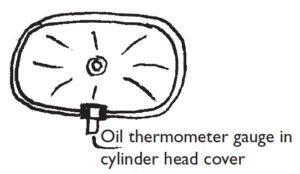 The main factor for an efficient heating is a hot engine: oil temperature 80-100C. The hotter engine the better heating. Mount an engine oil thermometer to give you control of your insulations and to prevent overheating (which is practically impossible in -30C). The oil thermometer gauge can be fitted in the oil sump, but a better place is in the cylinder head cover (needs drilling a hole in the bottom of the cover). You will get more reliable readings and the gauge is protected against chocks and cold air flow. You can also consider an oil pressure meter in addition to the warning light.
The main factor for an efficient heating is a hot engine: oil temperature 80-100C. The hotter engine the better heating. Mount an engine oil thermometer to give you control of your insulations and to prevent overheating (which is practically impossible in -30C). The oil thermometer gauge can be fitted in the oil sump, but a better place is in the cylinder head cover (needs drilling a hole in the bottom of the cover). You will get more reliable readings and the gauge is protected against chocks and cold air flow. You can also consider an oil pressure meter in addition to the warning light.
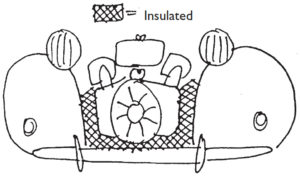

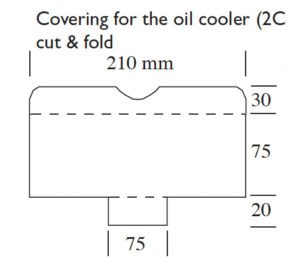 Block all the holes to the engine room in the front. Cover the oil sump, space between bumber and chassis as also between engine and front wings. Cover the oil cooler and all the little holes behind the fan. Cut a piece of thin metal or plastic to cover the cooler. Also you can easily mount a piece behind the cooler and slide it sideways to regulate the effect. Block the cooling tubes to disc brakes.
Block all the holes to the engine room in the front. Cover the oil sump, space between bumber and chassis as also between engine and front wings. Cover the oil cooler and all the little holes behind the fan. Cut a piece of thin metal or plastic to cover the cooler. Also you can easily mount a piece behind the cooler and slide it sideways to regulate the effect. Block the cooling tubes to disc brakes.
Now use the covering of he grill (the muff) to regulate oil temperature, actually the muff should always be left a little open to get better air flow through the heat exchangers. Also leave some of the insulations easily removable if the weather gets warmer. Your oil thermometer guides you what to do.
You can also insulate other surfaces in the engine room with suitable material. This also reduces engine noise which is always a little higher with heating turned fully on.
Wash the engine from outside to avoid smell from the hot engine room with the heating.
Check the condition and mounting of the heater tubes: use the original type, they are rather good against cold and noise. Insulate the heat exchangers from outside with fireproof material and check that the levers are closing properly. There is normally a lot of air leak around the cylinder heads coverings: check the spark plug holes and where the inlet and outlet tubes come through. You can block the slots using heat resisting sealant. Block the outlet holes for heating tubes in inner wings.
INSULATE ALSO THE INSIDE
Normally in -20C the air coming inside from the heaters is about 60-70C if the engine has reached the recommended operating temperature. Under your seat the temperature has already fallen to +20 and in the back seat it is already freezing. Where does the heat disappear?
The main reason is the floor: just a rubber mattress do not give much insulation. The floor is a terribly efficient cooler ruining all the good work you did in the engine room. Cover the floor completely with a large piece of light weight insulating material (like cell plastic that they use for camping mattresses). Under this insulation you can put old newspapers to suck possible water. Some people use a plastic grid (like in bathrooms) under the insulation to let the floor dry. Also insulate the space behind door panels.
Close all the holes and cracks in the bodywork. Attention to door sealings (corners), flap windows (they need thin extra sealing), ventilation flap and the chest of the body where all the cables, levers and steering come through. Put a bright lamp in the other side and you can see all the holes easily where the light shines through. Now fill them with a sealant. Normally you make no notice of those little holes, but in -20C you will find the slighthest draft most annoying during hours of driving.
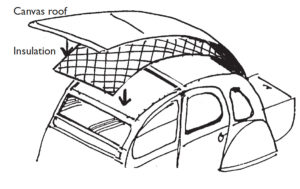 The insulation of the roof is very important. You may have a hard top, but usually without proper insulation. For canvas roof, use a large piece of flexible insulating material (same as for the floor, thickness about 1cm). Cut it to the same size as the roof and just put it between the canvas and the body. You can cut the edges a little thinner and the roof can be tightly closed on that material. Easy and efficient. Attention to the tightness of the front bar of the roof.
The insulation of the roof is very important. You may have a hard top, but usually without proper insulation. For canvas roof, use a large piece of flexible insulating material (same as for the floor, thickness about 1cm). Cut it to the same size as the roof and just put it between the canvas and the body. You can cut the edges a little thinner and the roof can be tightly closed on that material. Easy and efficient. Attention to the tightness of the front bar of the roof.
There should be a constant dry and warm air flow through the cabin to keep the windows clear. This is a weak point in a 2CV. The heat comes mostly to the floor and to your wet feet and the blow is not very strong. You can improve it a little by using pieces of tubes pointing upwards or to the side windows. On the other hand the cold glass surfaces take a lot of power from the heating.
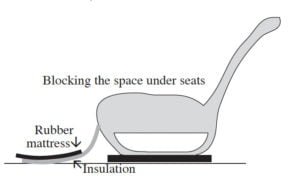 Do not insulate the boot lid. For better ventilation there should be outlet holes somewhere in the back of the car. Blocking the space under the front seats leads the heat upwards and those sitting in the front will feel much warmer. Block also under the back seat. If you remove the back seat it will feel more drafty in the cabin.
Do not insulate the boot lid. For better ventilation there should be outlet holes somewhere in the back of the car. Blocking the space under the front seats leads the heat upwards and those sitting in the front will feel much warmer. Block also under the back seat. If you remove the back seat it will feel more drafty in the cabin.
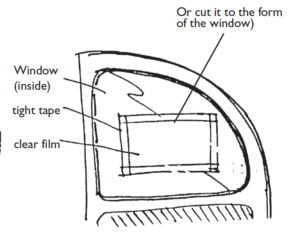 You can make “double windows” in you 2CV. The easiest way is to tape a thin plastic film on the inside of the windows to form an air pocket. Another way is to cut thin acryl sheet to the form of a window and glue it with silicone on the glass (closer instructions available from Jukka). Works well and the glass surfaces are not so cold! For rear window you can also use a heated one or mount a fan.
You can make “double windows” in you 2CV. The easiest way is to tape a thin plastic film on the inside of the windows to form an air pocket. Another way is to cut thin acryl sheet to the form of a window and glue it with silicone on the glass (closer instructions available from Jukka). Works well and the glass surfaces are not so cold! For rear window you can also use a heated one or mount a fan.
The ice formed on the windows during the nights can be like steel. Bring a half-cover to wrap your car up for longer stays. You will also need a brush for clearing the snow and a scraper for removing the ice from the windows. If you have an interior heater (230 V) for your car, there is the possibility for using it in many overnight spots. Only use those designed to work outdoors and in cold.
If properly insulated, 2CV’s heaters are quite sufficient. Still, many people use petrol (or diesel) burning extra heaters (Eberspächer, Bahco…). They are powerful but expensive. An efficient fan for the inlet is much cheaper and easier to mount.
Electrically heated seat covers are very comfortable, but a thick warm blanket creates a closer atmosphere. An in/outdoor thermometer can be quite a good “heater”, too: believe it or not it is warmer inside! Or check if you can see your breath. It stops steaming in about +10C.
LOCKS
Dismantle, clean and grease the locks in front doors and the boot if you want to use them in Lapland, too. Use gun oil or synthetic motor oil. Keep a small spare bottle of antifreeze stuff for locks in an unlocked place like engine room.
COLD STARTING
If you like to practise cold starting, here is a short checklist for about -10 or colder. Turn the ignition on and see that there are no other electrical divice on. Pump the gas pedal a couple of times, pull the choke fully on, push the clutch pedal down and start until the engine responds, but not longer than for about 5-10 seconds. If the engine does not start, turn the ignition off, wait a little and repeat the previous. If there is still no success, push the choke off to avoid wet plugs. Now start again, pump the gas pedal slowly up and dow and pull the choke on little by little to find the correct mixture for the spark.
When the engine starts, keep the cluch down for some time and the engine runs more easily. If it did not start, turn the key off and have a longer break. During the pause check for example if there is fuel leaking under the carburettor as it should (there is a small hole in the tube under) or turn the engine with the crank to soften the oil in the bearings. Anyway, 2CV´s behave according to their character in cold, so you may know the soul of your friend much better. Some need a lot of fuel by pumping the pedal and some get wet plugs easily. The golden rule is to take it easy! Try to save the battery.
If you still cannot start, you should warm up the inlet tubes under the carburretter somehow. For example put plastic bags (use two or more bags on top of each other to prevent water leaking to the engine) with some hot water over the tubes and soon the miracle happens! Pull the choke on just before stopping the engine for a longer time. It will help the next cold starting as unburned fuel has remained in the tubes and cylinders.
Do not let your engine run without driving for a long time. A lot of water will be formed inside the exthaust pipe which will be frozen up when you turn off the engine. You can mount a switch to turn the alternator off for starting and warming up. Without the resistance from the alternator the engine turns more easily.
SPARE PARTS
Bring basic spares with you like fuses, bulbs, spark plugs, breaker points, alternator belt etc. Consider also wiper blades, alternator, propeller and a drive shaft. Also Carry extra fuel (about 5l), brake fluid and engine oil in your 2CV. Also you need a tow rope, shovel, starting cables and a first aid kit.If you have the Apua-Help 2CV Road Service booklet, there is a practical list of spare parts, tools and technical facts about 2CV in the booklet. Hope you have no problems preparing your 2CV. Do not hesitate to ask the organisers if in doubt and also do not throw away your own ideas.















